Fail-Safe design 01 [Column_Tracksides]
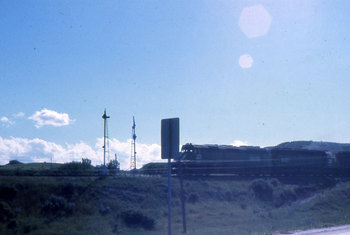 : somewhere in MT, summer, 1971
: somewhere in MT, summer, 1971I don't know well about the technical design. But I can understand that the semaphore has the form came from the theory of fail-safe. The "RED" signal has more stability than that of the "GREEN" signal. It's same here in Japan.
The difference is that the "GREEN" signal for BN freight led by EMD F45 6628 is in upright position, contrary to the "GREEN" signal for the JR express "SAKYU" is in downward. I think that it's a kind of difference that you "push" the saw, while we the Japanese "pull" the saw.
But I think that the upright position is more suitable for the "GREEN" than the downward position. The upright position brings me the atmosphere of "Here we go".
車中からとっさに撮った写真だが、腕木式信号機が写っている。写真右(奥)側の信号機がEMD製F45が牽く貨物列車に「進行」を現示しているのが分かるだろうか。
北米の腕木式信号機では腕がほぼ垂直に上がっている状態が「進行」である。一方、日本では下に下がっている状態が「進行」である。どちらも、なんらかの不具合があった場合「停止」を示すよう、"fail safe"の思想に基づいて設計されているはずである。両者の違いはどこからくるのだろう。筆者は技術的な知見にうといので、のこぎりの「押す」と「引く」の違いのようなものかと思っている。
ただ、腕が上がっている方が、"Here we go"という感じがするのはわたしだけだろうか。
北米の列車無線を聞けるHP;
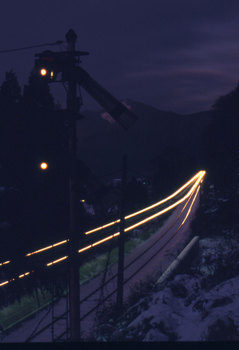 : Mimasaka-Kawai Okayama Pref. Japan, Dec. 17, 1994
: Mimasaka-Kawai Okayama Pref. Japan, Dec. 17, 1994Fail-Safe design 02 [Column_Tracksides]
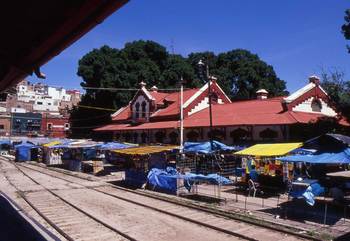 : Guanajuato Mexico, Sep. 22, 2002
: Guanajuato Mexico, Sep. 22, 2002The train order signal at Guanajuato, Mexico has only one eye. I wonder what is the purpose for this signal at this terminal depot.
K氏から、日本でも上向きの腕木式信号機があったことを教わった。いずれの型でも腕が水平であるとき「停止」である。Steinheimer氏の写真集"A PASSION FOR TRAINS"のPLATE 131として、Southern Pacificの信号機をアップで撮った作品が掲載されている。駅舎の前や屋根上に設置される、3位式の"train order signal"である。この写真の信号機では、腕が水平であるとき「停止」ならば、「進行」は腕が下がったときとなることが分かる。このように、現示の方法には色々あるようである。
筆者の知っているところでは、色灯式ではあるが、黄色の点滅などという現示もある。Rio Grandeにおいて黄色の点滅は"approach medium"の意だそうである。実際に点滅している様をDVDの画像に見ることができる。また、消灯は"restricting"を示すそうである。こうなるとfail-safeとは言い難い。
信号機に関して不可思議に思っているもののひとつに、終端駅に設置された"train order signal"がある。
写真は、既に廃線になったNATIONAL of MEXICO(メキシコ国鉄)のGuanajuatoという終端駅である。腕が無くなってしまっているが、"train order signal"が写っている。腕木式信号機の色灯レンズがひとつしかないのは、消灯にも意味があったか、それとも常に同じ現示であったか。更に、全ての列車が停車するであろう終端駅に"train order signal"は要るのか、という疑問もわく。出発信号機のような役割を担っていたのだろうか。
Fail-Safe design 01;
http://riogrande.blog.so-net.ne.jp/2010-02-26
TransPacificにおいて腕木式信号機に言及するページ;
http://works-k.cocolog-nifty.com/page1/2006/10/y_7e7c.html
dda40x氏のブログGiants of the Westにおいて黄色の点滅信号に言及するページ;
http://blog.livedoor.jp/dda40x/archives/2007-07.html#20070707
Why we collect? 01 [Column_Tracksides]
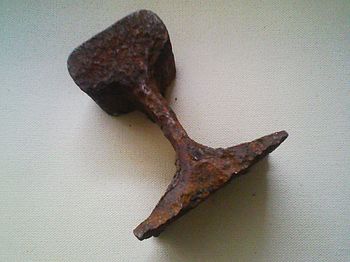 : a kind of junks
: a kind of junksMy friend who was the auctioneer of the Sotheby's told me as follows. The history of art is a history of collectors. And the collection has a power, which is stronger than power of politics, economy, or military.
Yes, we know Lorenzo de' Medici, the great collector, or Jiang Jieshi, the transporter of the treasures from the Forbidden Palace in Beijing to Taipei, as the facts for his explanation.
Well then why we collect or work on models?
Do we do so to tell a history of model railroading? Do we do so to show the power of models?
May be not. My collection is cheaper than the case. It looked like chocolates for my friend. It's a kind of junks for the others.
The explanation to the collection by my friend does not fit to our hobby.
ハーバードMBAにしてイギリスのオークション会社サザビーズの元日本代表であるS氏によれば、美術史はコレクションの歴史でもある。確かに、ルネサンス期におけるメディチ家のコレクションを始め、美術史は古今東西のコレクションによって語ることができる。
また、コレクションはPowerでもあり、しかも軍事や政治、経済をしのぐ力となり得ることは歴史が示しているという。蒋介石がなぜ台湾にまで故宮の文物を携えていったか。それは文物が力であったからである。
さて、ではわれわれはなぜ模型を制作・収集するのだろう。
歴史を語るためだろうか。確かに雑誌にそのような模型発展史の連載記事がある。しかし、当初から歴史を語る意図を持って制作・購入しない限り、その時点でそれが歴史になるという認識はないだろう。
では力だろうか。大変な資力や労力を費やしたことがうかがえるコレクションには、確かに圧倒されるものがある。しかし、筆者のそれのような、ネットオークションで落札した、中身より陳列ケースの方が高価なものに、そのような力を覚えることはないだろう。
これは模型の制作・収集に限らず、プロトタイプの写真撮影やパーツや切符などの収集、保存活動など鉄道趣味全般にも該当するように思う。われわれの制作物・収集物は、余人にとってはガラクタ・つまらないモノである。余人には理解しがたいわれわれの趣味の原動力がどこからくるのか、考えてみるのも面白い。
Why we collect? 02 [Column_Tracksides]
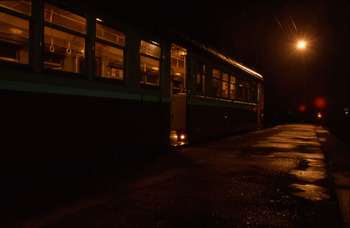 : day's last train bound for Kichigahara, Okayama, Japan, abandoned in 1991
: day's last train bound for Kichigahara, Okayama, Japan, abandoned in 1991I found an interesting sled "Modeling Era by Age" in the Atlas Forum. There are about 50 comments replying the question. The average modeling era by age is of 2 years old. 7 model the age of 0 to 5. 5 model the age of 6 to 10. Also 5 model the age of 11 to 15. These show the fact that the many model the age of their childhoods. I also model the age of 10 to 11.
We can say that we reappear the object which we miss a lot as a model. This fact is comprehended as the diagram that the relationship between the prototypes and us the enthusiasts is reappeared in the relationship between us the modelers and the models.
In this diagram, we the enthusiasts and the models are both placed in the same place, the object. Eventually, we the enthusiasts, in other words, our childhoods are buried in the models.
Our childhoods are also the missed a lot. Moreover, we want to meet again with it which never fulfilled. Therefore the desire never disappears. So we are forced to keep collecting or modeling.
Lacan explains this diagram as the "symbole".
Atlas Forum "Modeling Era by Age";
http://forum.atlasrr.com/forum/topic.asp?TOPIC_ID=59547&whichpage=1
AtlasのForumに興味深いスレッドを見つけた。「あなたは今何歳で、いつ頃を趣味の対象としているか?(Modeling Era by Age)」というスレッドである。約50の標本から算出すると、平均では2歳、最も多いのは自分が産まれた頃とする者が7,次いで6〜10歳および11〜15歳が各5であった。つまり、自分の幼少期を趣味の対象としている者が比較的多いことが分かる。
われわれにとってはごく自然な結果のように思われる。すなわちわれわれは、既に失われてしまった慣れ親しんでいたものを、模型という形で再現しているのだと理解できる。プロトタイプとわれわれの関係が、われわれと模型の関係として再現されている。
この2つの関係において主(subject)、つまり消えるのはプロトタイプであり、収集・制作するのはわれわれである。客(object)、つまり消えられるのはわれわれであり、収集・制作されるのは模型である。
この2つの関係は再現というかたちで重なる。したがって、プロトタイプとの関係におけるわれわれは、再現される関係においては模型の位置にある。つまり、模型には、プロトタイプとの関係におけるわれわれ、幼少期の自分が形を変えて埋め込まれているのである。
幼年期の自分もまた、既に失われたものである。しかも(自分探しではないが)それに出会いたいと思わせるものである。ところが、それは当然ながら叶わないものである。したがって、その欲望は潰えることなく駆動し続ける。だから、われわれは自分の幼年期が埋め込まれた模型を求め続けるのである。ラカンはこの再現劇を象徴化として定式化している。
Why we collect? 03 [Column_Tracksides]
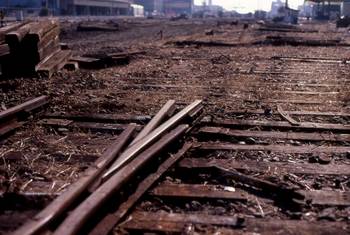 : Osaka Japan, Feb 11, 1998
: Osaka Japan, Feb 11, 1998What do we achieve through the Symbolizing?
We can read many articles on abandonments in hobby railroading magazines, which seldom seen in other fields.
Missing the object of our hobby is an injury. Our heart aches. The articles on the magazine reappears the fact using the words. Lacan explains that the injuries are cured through tracing them using the words, which make the injuries like scabs. The injury of missing the object of our hobby is cured through symbolizing the fact by collecting or modeling.
Image your barefoot struck the furniture in your house. You can't say a word that moment. Next moment, you shout "Ouch!" or you may make a grimace. Reappearing the injury by that may make you a little better. The missing of the object of our hobby is made better by symbolizing the injury through collecting or modeling.
If this hypothesis is true, there are no enthusiasts without the experience of trains in their childhoods. How about you?
象徴化することで、われわれは何を得ているか。
鉄道趣味誌では廃車や廃止の記事をよく見る。これは他の分野の趣味誌にはあまり見られない。新しいものについての記事は一般的であるが、こういった失われるものについて、この分野ほど注目する趣味誌は他にないのではないか。
われわれ鉄道趣味人にとって、趣味の対象が失われることは損失である。それはわれわれの心を痛める。鉄道趣味誌の記事は、この損失をことばで再現する。フロイトは患者が何度も悪夢を見ることを「反復強迫」といった。何度も悪夢を見ることで、心がその痛みを癒そうとしていると考えた。ラカンはそれを展開し、傷はことばというひとに与えられた道具でなぞることで、かさぶたのようなものに置き換えられると考えた。趣味の対象を失うという心の傷は、そのできごとをことばで象徴化することによって治癒されるのである。
家の中でタンスの角に足の指をしたたかぶつけた様を思い浮かべてほしい。ぶつけた瞬間は声もでない。次の瞬間、「痛ったあー」ということばやしかめっ面という表情でその痛みをなぞることで、痛みは和らげられたように感じ、忘れることができる。これと同じように、われわれは趣味の対象が失われた痛みを、収集や制作による再現という象徴化によって和らげていると考えられる。
もし、この仮説が妥当であるなら、幼少期に「きしゃ」を失わなかった者はこの趣味には陥らないことになる。また、「きしゃ」は失われることで、趣味の対象になり得ることになる。
Sounds of trains 01 -horns [Column_Tracksides]
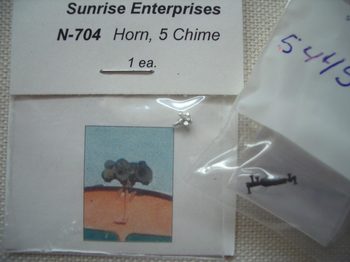 : dead stock Sunrise and Atlas horns
: dead stock Sunrise and Atlas hornsMany enthusiasts devote themselves to the sound of railroad or trains. I also love the sound of 5 chime horns installed on the diesel locomotives in United States.
In the Pentrex DVD I mentioned before, the Rio Grande train approaches the glade crossing, blowing the ordinal −−・− horns. As this Rio Grande SD50 has 3 low tone horns facing front and 2 high tone horns facing back, the chord changes drastically as soon as the train clears the video camera.
I wonder why they do like that. I think the high tone horns more attract attention than low tone horns. Is it to reduce Doppler effect? Well then why? Or, is it to represent the direction of the locomotive? My question leaves uncertain.
Anyway, I do love this effect. Is there anyone who succeeded to represent this by today's DCC technology?
The Five Chime Consultants Web Page;
Pentrex DVD I mentioned before
Sound of trains 02 - prime movers [Column_Tracksides]
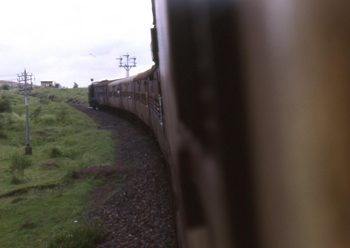 : Aurangabad India, Sep. 6, 1996
: Aurangabad India, Sep. 6, 1996I also love the sound of EMD 645 prime movers. The sound of Rio Grande east bound train running 8 at the Glenwood Canyon is one of my all time favorites.
You know that EMD locomotives have 2 stroke engines and GE locos have 4 stroke engines. And then, how comes that brisk sound and black smoke from their 4 stroke engines?
Because of the brisk sound of chain saws, I have the image that brisk sound comes from 2 stroke engines. I also think that lubricating oil burning 2 stroke engines may exhaust more dirty smoke than 4 stroke engines.
When I took the train to visit Ellora Caves in India, The train was led by an ALCO locomotive. The sound and black smoke of the locomotive made me a misapprehension of riding a steam locomotive powered train.
The diesel locomotives of Japanese National Railways had 4 stroke engines, too. But they didn't make sounds and smokes like that.
Rio Grande at Glenwood Canyon;
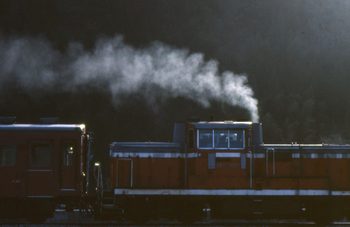 ; Teramae Hyogo Japan, Mar. 7, 1992
; Teramae Hyogo Japan, Mar. 7, 1992Sound of trains 03 - rail joint and or music [Column_Tracksides]
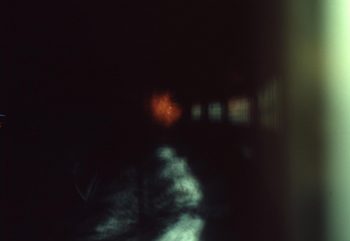 : Wadayama Hyogo Japan, Mar. 7, 1992
: Wadayama Hyogo Japan, Mar. 7, 1992The rhythmical sound caused by wheels and rail joints is the sound attracts us. Though the extension of the long rail may diminish the opportunity to hear that, it still remains as the principal element of the image of railroading.
Music also cannot be formed without rhythm. Therefore, I think that train and music are familiar with each other. Wasting the time on the midnight train with SONY Walkman was one of my luxurious memories.
Sometimes, train or railroad is sung in a song. When I was living in United States, "Midnight train to Georgia" sung by Gladys Night & the Pips was heavily heard on the radio. I also loved this song.
In this song, a couple is going to take the midnight train to Georgia. In the original lyrics, they were going to take the "midnight plane to Houston". While covering the song, train thought to be better for the two whose dream was shattered, Georgia thought to better than Houston for the destination of the trip.
Sunset Limited would be the best choice for traveling from LA to Georgia. I don't know whether the Sunset Limited departed LA in the night. But, I also agree with that change. The two should take the train to Georgia, not the plane to Houston.
"Midnight Train to Georgia" by Gladys Night & the Pips
Sound of trains 04 - train and music [Column_Tracksides]
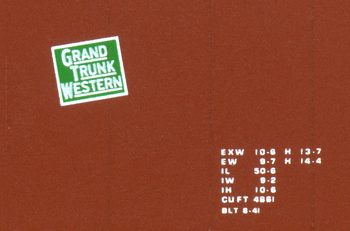 : MTL 34170, GTW boxcar
: MTL 34170, GTW boxcarTalking about railroad oriented words in the sphere of music, I should mention about the proper nouns. For example, we know the rock band, Grand Funk Railroad. Grand Trunk Western Railroad was their root of the name. The title for their first album "On time" (1969) sounds nice to us, too. Maybe you have heard the song titled "The Loco-Motion"(1974).
Recently, the band named Train made a big hit "Hey, Soul Sister"(2009). I donユt know their source of the name, but their slack, or simplicity may indicate the period.
Talking about '70s, I should mention about the "Soul Train" TV show (1971-2006). I used to watch, excited at the steam locomotive oriented animation and opening theme.
I also should mention about Woody Guthrie, who died in 1967. He sang his life as a hobo, which was one of the parts of the railroad culture and also the hotbed of the hobo culture itself. Ry Cooder represented his way of life in the album "Boomer's Story"(1972).
Maybe we can find much more facts in the field of blues or work songs.
By the way, the picture above was taken using a scanner, not a camera. It gives me an illusion of tracing back the manufacturing process done by MTL.
The Loco-Motion by Grand Funk Railroad;
Hey, Soul Sister by Train;
Theme for Soul Train;
Web site for hobo culture;
Speed Limits in Rio Grande Employee Time Table [Column_Tracksides]
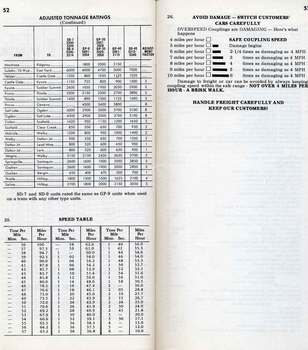 : page 52-53 of the time-table
: page 52-53 of the time-tableAt the last page of the ETT, we can read that the speed should not exceed 4mile/hour when coupling. Scale speed for 4mile/hour is 1.1cm/sec in N scale, 2.0cm/sec in HO, and 3.7cm/sec in O. If we can achieve this in our model, we can enjoy a lot even on the small section.
Today, we have many kinds of N scale metal wheels from the manufacturers like BLMA, Fox Valley, Intermountain and Atlas. These metal wheels may archive the "4mile/hour", though I have neither.
Chapter for Signals in Rio Grande RULES & REGULATIONS [Column_Tracksides]
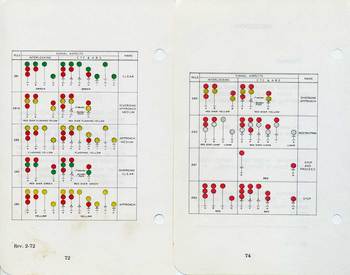 : page 72 and 74 of the rulebook
: page 72 and 74 of the rulebookHere is the only color printed pages from the rulebook; the chapter for signals.
I have no information for the meanings of "A" to "K" illustrated under the signals.
Also left unknown is the "P- Marker". It maybe important since the only deference between the two, "E" signal on rule 291 and "G" signal on rule 292, is the "P - Marker" (name for "E" signal is STOP AND PROCEED, and the name for "G" signal is STOP. See page 74 above).
I also found an interesting aspect while I was watching the DVD "DENVER & RIO GRANDE WESTERN" from Pentrex.
The signal stands by the turnout and faces to the main. Before the train passes the signal on the main, the aspect is "LUNAR", not lighted. When the locomotives on the head of the train pass the signal, it lights red. And then, when the whole train passes the signal, it turns "LUNAR" again. I wonder who watches this aspect.
my web page introducing DVD "DENVER & RIO GRANDE WESTERN";
Sound of Trains 05 - Whistle Signals at Rio Grande [Column_Tracksides]
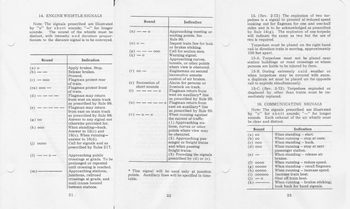 : page 21, 22, 23 of the rulebook
: page 21, 22, 23 of the rulebookToday, we can enjoy whistling in model railroading using DCC. So, the rules for engine whistle signals would help us enjoy running our engines.
The image above is the list for the engine whistle signals at Rio Grande. "- - o -" would be the most familiar engine whistle signal for us.
Besides engine whistle signals, there are communicating signals using whistle and or hand signals.
Here in Japan, JNR engineers on the double headed train or the train with the helper engine used engine whistle to communicate each other. For example, "- oo" was "shut off regulator when running" and "oo - " was "back when standing".
There is no "shut off regulator" whistle signal in Rio Grande rulebook. I wonder how they communicate and operate the narrow gauge steam trains.
Sound of trains 06 – train related songs [Column_Tracksides]
: Rod Stewart & Jeff Beck
Thanks to the contributors of “railroad songs..” thread at Atlas forum, I came to know more train related songs.
I would like to add some songs with videos featuring trains on youtube to my “Sound of trains” column. Here, the songs I didn’t mention before:
Blues
"Riding on the L&N" by John Mayall, with some steam train videos taken maybe in the ‘50s. I couldn’t identify the road.
Country and Western
“Life's Railway to Heaven” by Johnny Cash, with some steam train videos including New Heaven streamlined 4-6-4, #1400 and 4-6-0.
“Train Song” by Ralph Stanley, with PC, GN, SP and CN diesel engine photos.
"Canadian Railroad Trilogy" by Gordon Lightfoot, with modern NS freight train videos.
"The L&N don't stop here anymore", with L&N photos including engine #831.
Rock
“People Get Ready” by Rod Stewart & Jeff Beck, official PV featuring maybe SP local train, EMD SW or MP pulling BN and SP boxcars.
“Casey Jones” by Grateful Dead, with on board views from the Empire Builder.
"Driver 8" by REM, official PV featuring Chessie diesel engines #s 8558, 4329, 8289, 4117 and 4409, yard moves, shop works and freight trains, taken at Clifton Forge, VA.
Sorry, if the categorizing of songs are incorrect.
: REM
Thanks to the contributors of “railroad songs..” thread at Atlas forum, I came to know more train related songs.
I would like to add some songs with videos featuring trains on youtube to my “Sound of trains” column. Here, the songs I didn’t mention before:
Blues
"Riding on the L&N" by John Mayall, with some steam train videos taken maybe in the ‘50s. I couldn’t identify the road.
Country and Western
“Life's Railway to Heaven” by Johnny Cash, with some steam train videos including New Heaven streamlined 4-6-4, #1400 and 4-6-0.
“Train Song” by Ralph Stanley, with PC, GN, SP and CN diesel engine photos.
"Canadian Railroad Trilogy" by Gordon Lightfoot, with modern NS freight train videos.
"The L&N don't stop here anymore", with L&N photos including engine #831.
Rock
“People Get Ready” by Rod Stewart & Jeff Beck, official PV featuring maybe SP local train, EMD SW or MP pulling BN and SP boxcars.
“Casey Jones” by Grateful Dead, with on board views from the Empire Builder.
"Driver 8" by REM, official PV featuring Chessie diesel engines #s 8558, 4329, 8289, 4117 and 4409, yard moves, shop works and freight trains, taken at Clifton Forge, VA.
Sorry, if the categorizing of songs are incorrect.
: REM
2012-01-27 12:06
コメント(0)
Happy – thoughts on cab ride videos [Column_Tracksides]
: Pharrell Williams - Happy
Here is an hour movie clip, which cannot stop watching until the end, resembles cab-ride videos. This is a part of Pharrell Williams’ 24 hours music video*. I chose the clip shot at LA Union Station.
The characteristic of this movie, shot using Steadicam, is that it represents a smooth move with a simple rhythm. It neither uses shooting nor editing techniques like zoom or cut. In a sense, it’s like a painting. This view would be understood if you compare with the TV CM of Shinkansen shown below.
If you carefully watch the making of this movie, you can find a choreographer dictating the dancer**. It looks as if the dancer is dancing free, but the dancer is imitating the choreographer. So to speak, the performer in front of the camera is a reflected image of the person behind the camera.
2C_by_Velazquez.jpg) : Las Meninas by Diego Velázquez
: Las Meninas by Diego Velázquez
The analysis of the painting “Las Meninas” by French philosopher Michel Foucault would be suitable for such a complicated relationship of gazes. “Las Meninas” is a 1656 painting by Spanish artist Diego Velázquez.
Jacques Lacan also writes about such a relation; one’s looking a painting as “The painting surely is in my eye. But, as for me, I’m in the painting ”. In a word, one who looks a painting is gazed, and there one sees one’s irreplaceable self-image in the painting.
Then, what one sees in the movie “Happy”? As I wrote, the performer in the movie is a reflected image of the person behind the camera. The one who watches the movie is also situated behind the camera. Therefore, the one who watches the movie sees one’s self-image identified with the performer.
Cab ride videos also represent smooth moves with a simple rhythm. They neither use shooting nor editing techniques. At a glance, there are no performers in cab ride videos. But you usually see the window frame and/or nose and/or handrail of a locomotive from inside the cab.
As for the reflected images I mentioned before, left and right are reversed. Then if you reverse the cab ride view the other way, you will get the appearance of the particular locomotive you ride. Therefore, at the cab ride videos, the locomotive plays the part of choreographer at the movie “Happy”. Thus, the structure of the cab ride video is the same as “Happy”.
Now, we can see that one sees one’s self-image identified with the locomotive in cab ride videos. I think that’s why we cannot stop watching cab ride videos till the end, because the self-images are irreplaceable for ourselves.
Contributor “i am OTHER”, which reminds us of the famous phrase “Je est un autre (I am an other)” by Arthur Rimbaud, is the name of the creative unit headed by Pharrell Williams. Lacan also tells us that “désir est désir de l'Autre (desire is the desire of the Other)”. Therefore, I think it’s not necessarily irrelevant quoting Lacan’s thought in this analysis.
* web page for 24 hours video;
** making of “Happy” at Youtube;
: Kyushu Railway Company TV CM
Here is an hour movie clip, which cannot stop watching until the end, resembles cab-ride videos. This is a part of Pharrell Williams’ 24 hours music video*. I chose the clip shot at LA Union Station.
The characteristic of this movie, shot using Steadicam, is that it represents a smooth move with a simple rhythm. It neither uses shooting nor editing techniques like zoom or cut. In a sense, it’s like a painting. This view would be understood if you compare with the TV CM of Shinkansen shown below.
If you carefully watch the making of this movie, you can find a choreographer dictating the dancer**. It looks as if the dancer is dancing free, but the dancer is imitating the choreographer. So to speak, the performer in front of the camera is a reflected image of the person behind the camera.
2C_by_Velazquez.jpg) : Las Meninas by Diego Velázquez
: Las Meninas by Diego VelázquezThe analysis of the painting “Las Meninas” by French philosopher Michel Foucault would be suitable for such a complicated relationship of gazes. “Las Meninas” is a 1656 painting by Spanish artist Diego Velázquez.
Jacques Lacan also writes about such a relation; one’s looking a painting as “The painting surely is in my eye. But, as for me, I’m in the painting ”. In a word, one who looks a painting is gazed, and there one sees one’s irreplaceable self-image in the painting.
Then, what one sees in the movie “Happy”? As I wrote, the performer in the movie is a reflected image of the person behind the camera. The one who watches the movie is also situated behind the camera. Therefore, the one who watches the movie sees one’s self-image identified with the performer.
Cab ride videos also represent smooth moves with a simple rhythm. They neither use shooting nor editing techniques. At a glance, there are no performers in cab ride videos. But you usually see the window frame and/or nose and/or handrail of a locomotive from inside the cab.
As for the reflected images I mentioned before, left and right are reversed. Then if you reverse the cab ride view the other way, you will get the appearance of the particular locomotive you ride. Therefore, at the cab ride videos, the locomotive plays the part of choreographer at the movie “Happy”. Thus, the structure of the cab ride video is the same as “Happy”.
Now, we can see that one sees one’s self-image identified with the locomotive in cab ride videos. I think that’s why we cannot stop watching cab ride videos till the end, because the self-images are irreplaceable for ourselves.
Contributor “i am OTHER”, which reminds us of the famous phrase “Je est un autre (I am an other)” by Arthur Rimbaud, is the name of the creative unit headed by Pharrell Williams. Lacan also tells us that “désir est désir de l'Autre (desire is the desire of the Other)”. Therefore, I think it’s not necessarily irrelevant quoting Lacan’s thought in this analysis.
* web page for 24 hours video;
** making of “Happy” at Youtube;
: Kyushu Railway Company TV CM
2014-06-06 09:00
コメント(0)
Telling a History 01 – Characteristic of Our History [Column_Tracksides]
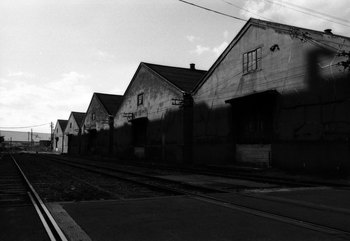 : spur abandoned in 1986. Osaka-ko, Osaka, Japan. 1986
: spur abandoned in 1986. Osaka-ko, Osaka, Japan. 1986History creates identity. And, our hobby has a factor of historical studies. Therefore, I think our hobby would help in establishing our identity. Does a community or a nation.
One gives evidence to tell a history. In some cases, evidence take the form of matters like remains, photos or papers. In other cases, evidence take the form of abstraction like narration. Even if one represents this evidence, the history told is a creation of the particular teller. Accordingly, there are many characteristics in telling history.
One of the characteristics in telling a history among our enthusiasm is that we often ask for the retirements or abandonment. These items are rare in standard histories, as standard histories follow the beginnings to describe the development, but not the demises.
For example, many standard design histories mention of the introduction of the PRR GG1 locomotive designed by Raymond Loewy. But few represent its entire life. Contrary to these histories, our histories often have both built dates and retired dates. Indeed, retired dates are useful in fits-my-era judging. But it may not be the only reason.
My question is that where this characteristic came from. Also is that what this characteristic work for. My guess is that it first comes from and works for the history teller himself because the history told is a creation of the teller.
2014-09-19 09:00
コメント(0)
Telling a History 02 – Theory of Repetition [Column_Tracksides]
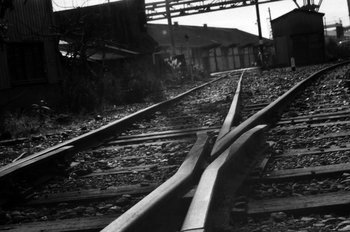 : spur abandoned in 1986. Osaka-ko, Osaka, Japan. 1986
: spur abandoned in 1986. Osaka-ko, Osaka, Japan. 1986Here, I’m considering the characteristics of the history among our hobby.
Most of our histories are told by the hobbyists. The passing of the object of hobby would be a nightmare for these hobbyists /historians. How does a historian recover from this wound?
Sigmund Freud studied wounded soldiers’ repeatedly dreamed wounds during the WW-1. From here, he extracted the theory of repetition. According to the theory, we repeatedly dream wounds to recover from the wounds.
We think we normally forget the wound to recover from it. But, the wound which should have been forgotten hides somewhere in the mind, where we call unconscious. This creates the repetitious nightmarish dreams. For what? To reduce the mental load, says Freud. Freud tells us that repetitious nightmarish dreams help us recover from the wound by addressing it in our mind.
As I wrote before, passing of the subject of the history would be a wound for the historian. Thus, if we can recognize the descriptions of retirements or abandonments as unconscious descriptions, we can recognize that a historian describes the retirements or abandonments to reduce his/her mental load.
2014-09-26 09:00
コメント(0)
Telling a History 03 – Unconscious Description [Column_Tracksides]
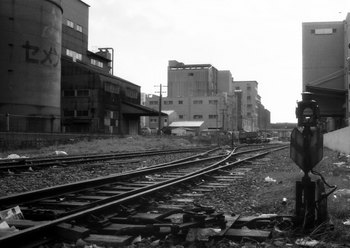 : spur abandoned in 1986. Osaka To-ko, Osaka, Japan. 1986
: spur abandoned in 1986. Osaka To-ko, Osaka, Japan. 1986Here, I’m considering the characteristics of the history regarding our hobby.
If we can recognize the descriptions of retirements or abandonments as unconscious descriptions, we can recognize that a historian describes the retirements or abandonments to reduce his/her mental load. Let’s see whether these descriptions are consciously or unconsciously written, through an example I found.
British historian Hamilton Ellis represents the development of British passenger equipment as a 176 pages book “NINETEENTH CENTURY RAILWAY CARRIAGES” (Modern Transport Publishing Co., 1949). Here, he represents the development by describing the beginnings of new equipment in chronological order. Accordingly, dates appear in the book roughly grow every other page, alike standard histories.
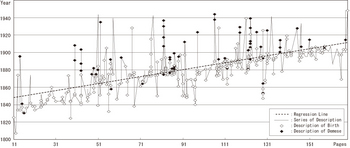 : line graph showing the series of dates appear in Ellis’ book
: line graph showing the series of dates appear in Ellis’ bookWhereas, the series of dates in his book occasionally jump up and down by the retired dates of equipment which he repeatedly inserts in his history. These descriptions of demise seem to disturb the overall flow. That is, these descriptions are meaningless in explaining the development of equipment: they can be caught as senseless descriptions.
According to the dictionary of psychoanalysis, an unconscious is a mental place of intellect made of senseless citation of letters. His descriptions of demise can be recognized as the senseless citation of letters. Therefore, these descriptions can be caught as unconsciously reproduced wounds. Freud’s theory of repetition tells us that unconsciously reproduced wounds reduce the mental load. That is to say, Ellis unconsciously describes the demise repeatedly to heal his mind.
2014-10-03 09:00
コメント(0)
Telling a History 04 – Objective Description [Column_Tracksides]
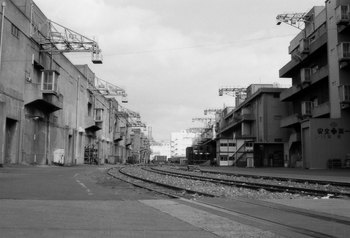 : spur abandoned in 1986. Osaka To-ko, Osaka, Japan. 1986
: spur abandoned in 1986. Osaka To-ko, Osaka, Japan. 1986Here, I’m considering the characteristics of the history among our hobby.
History teller subjectively selects the evidences. But the history he described should have objectivity. How the teller leads his subjective descriptions toward objectivity?
History teller unconsciously duplicates the demise repeatedly to reduce his mental load. Then, is there any advantage to us the readers besides fits-my-era judging?
Jacques Lacan answers to both questions. Lacan rebuilt Freud’s theory of repetition. Freud’s repetition meant the repetition of reproducing the wounds. But Lacan grasped it as a repetition of the relationship. From here, Lacan recognized the repetition as a process of becoming the other, a practice of investing things with symbolic meaning=languages. Both pronunciations and meanings of language is the other for us: we can’t create nor change. We have no choice but to accept it. Lacan represents this acceptance as becoming the other.
Lacan represents an example: relationship between frequently absent mother and a boy left behind is repeated as a boy throwing away the teddy bear with a shout. In our case, relationship between passed train and survived history teller, repeated as relationship between history teller and description of demise, may fit for the example.
Here, in Lacan’s example, boy’s position in “mother/boy” relationship is considered as transposed with shouted teddy bear in “boy/teddy bear” relationship. This transposition represents that the boy was shouted=given the meanings. In our case, teller’s position in “passed train/survived history teller” relationship is transposed with description in “teller/description of demise” relationship. That is, the survived teller is described=symbolized and given the meanings.
Attained meanings are the others for the teller. This means the teller attained an objective point of view within oneself. That is to say, the description of the teller heads toward objectivity.
Thus, repeatedly described retired dates lead both the history teller and us the readers toward objectivity. This maybe the answer for the two questions at the beginning of this column.
2014-10-17 09:00
コメント(0)
Telling a History 05 – Value of Our Hobby [Column_Tracksides]
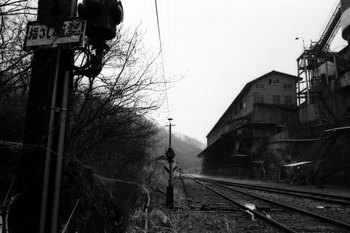 : spur abandoned in 1987. Yanahara, Okayama, Japan 1990
: spur abandoned in 1987. Yanahara, Okayama, Japan 1990Here, I’m considering the characteristics of the history among our hobby.
Our history often describes demise of the object of our hobby, which is rare in standard histories. Repeatedly described demises reduce our mental load and lead us toward objectivity through symbolizing.
I think our model trains or layouts also work. Here is the reason why I think so. We can suppose that the relationship between passed train and survived hobbyist is duplicated as the relationship between hobbyist and model trains. Here, model trains are the symbols of passed trains. Thus, survived hobbyist would be symbolized through duplication of relationship. Accordingly, modeling or layout making has a value of giving the meanings to our existences/lives.
I wrote before that our childhoods are buried in the models. We have the desire to meet again with them but never fulfilled. Thus, we are forced to keep collecting or modeling. Now, I should add another motive to our modeling of giving the meanings to our lives.
It is often said that hobby is a healing. But we may recognize that our enthusiasm is not almighty: it may only heal the wounded mentality caused by the pass of trains. Other than that, this hobby’s function of giving the meanings to our lives may have much more value.
My column “Why we collect?”;
2014-10-24 09:00
コメント(0)
Telling a History 06 – Prime Mover of Our Hobby [Column_Tracksides]
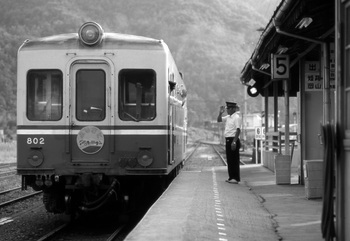 : departing train. Wake, Okayama, Japan Mar. 15, 1990
: departing train. Wake, Okayama, Japan Mar. 15, 1990Here, I’m considering the characteristics of the history among our hobby.
In the previous column, I wrote that our hobby gives the meanings to our existences. There, passing of trains meant retirements and abandonments. But I think departing trains and passing through trains may also be included in the idiom.
In Lacan’s scheme, the child repeatedly threw the teddy bear. And this repetition was an important matter at Lacan’s thought on child’s process of attaining a language: through this repetition, child attains the objective point of view. Retirements and abandonments of trains usually don’t repeat. I think that is why we repeat them as written histories or models.
On the contrary, repetition appears at departing trains and passing through trains: word “Daily” in a timetable assures the repetition. We probably miss and being wounded at the departing trains and passing through trains. But departing and passing take place repeatedly. This repetition itself helps us heal the wounded mentality. That’s why we usually don’t feel the wounds at departing trains.
This assurance for the repetition is rare at subjects of hobby beside ours. In other words, this assurance is one of the characteristics among the subject of our hobby. And the characteristic of our history, asking for the retirements and abandonments, is caused as a supplement for the lack of repetition. That is, the repetition is the prime mover of our hobby.
2014-10-31 09:00
コメント(0)
Rio Grande Right of Way at Thistle, Utah [Column_Tracksides]
Decades have passed since the vanishment of Denver & Rio Grande Western Railroad. But we still can quest for the survivor or remnants of Rio Grande along the route.
Here, I represent some of them we found during our vacation in Utah, as “Rio Grande Remnants”.
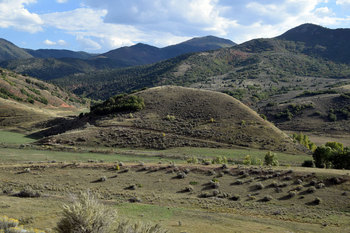 : Thistle, UT Sep. 15, 2014
: Thistle, UT Sep. 15, 2014
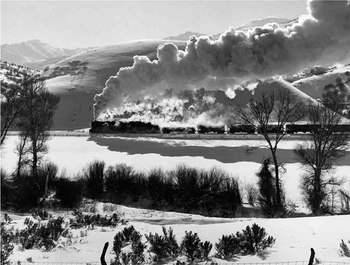 : "28 Degrees Below at Thistle, Utah, 1951," by Richard Steinheimer
: "28 Degrees Below at Thistle, Utah, 1951," by Richard Steinheimer
Thistle was silent when we visited. Heavy rain two days before brought all the weeds to green, some with bright flowers.
As you know, in 1983, a massive landslide filled the Spanish Fork River valley and created a reservoir. Everything including Rio Grande Main and Marysvale Branch sank under the water. Thus the detour was constructed in three months and the old route was abandoned.
I believe the straight trace at the bottom of the valley shown above is the remnant of old Rio Grande right of way just east of Thistle, Utah. And, I also believe that this is the exact point where Richard Steinheimer took the well-known photo of a coal drag powered by steam locomotive #1403, titled "28 Degrees Below at Thistle, Utah, 1951" *.
* Steinheimer photo on web;
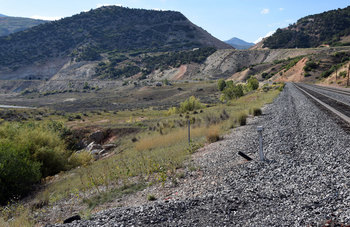 : Thistle, UT Sep. 15, 2014
: Thistle, UT Sep. 15, 2014
Here, I represent some of them we found during our vacation in Utah, as “Rio Grande Remnants”.
 : Thistle, UT Sep. 15, 2014
: Thistle, UT Sep. 15, 2014 : "28 Degrees Below at Thistle, Utah, 1951," by Richard Steinheimer
: "28 Degrees Below at Thistle, Utah, 1951," by Richard SteinheimerThistle was silent when we visited. Heavy rain two days before brought all the weeds to green, some with bright flowers.
As you know, in 1983, a massive landslide filled the Spanish Fork River valley and created a reservoir. Everything including Rio Grande Main and Marysvale Branch sank under the water. Thus the detour was constructed in three months and the old route was abandoned.
I believe the straight trace at the bottom of the valley shown above is the remnant of old Rio Grande right of way just east of Thistle, Utah. And, I also believe that this is the exact point where Richard Steinheimer took the well-known photo of a coal drag powered by steam locomotive #1403, titled "28 Degrees Below at Thistle, Utah, 1951" *.
* Steinheimer photo on web;
 : Thistle, UT Sep. 15, 2014
: Thistle, UT Sep. 15, 20142015-01-23 09:00
コメント(0)
Capturing Whole Consist, part 1 – Extras and Commuters [Column_Tracksides]
The whole consist of a train would be worth recording: I believe the records are useful when one makes up a model train of an era one models. Accordingly, I tried to record the whole consist of trains.
Records of the whole consist of a passenger train often appear in books and magazines by means of words and pictures. But the record of the whole consist of a freight train is few. The only one I remember is the fold-out page appeared in the Nov. 1995 Trains magazine showing the whole side view of a UP manifest by means of series of photos.
Capturing a whole train in a movie became relatively easy today by the development of the smartphone cameras. But doing the same in a photo would still be difficult: train is long and fast, and the right of way is crowded with the obstructions. Here is my quest:
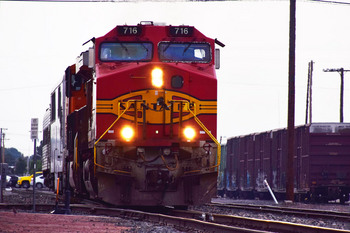 : Las Cruses, NM. Sep. 10, 2015
: Las Cruses, NM. Sep. 10, 2015
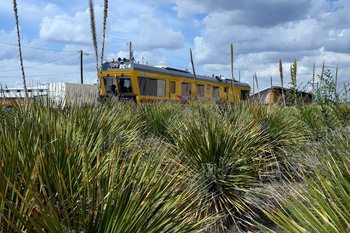 : Marfa, TX. Sep. 11, 2015
: Marfa, TX. Sep. 11, 2015
Extras are easy to capture the whole consist compared with the regular trains, as they are relatively short. But the problem is that it’s hard to predict the appearance.
The BNSF extra I happened to meet at Las Cruces, NM has consisted of only four; two locomotives and two MOW cars, BNSF #80 and #81. The UP extra I barely caught over the yucca at Marfa, TX has also consisted of four; two locomotives, a flat car, and a track inspection car #EC-4.
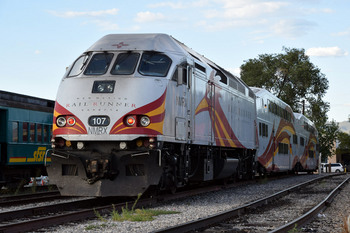 : Santa Fe, NM. Sep. 13, 2015
: Santa Fe, NM. Sep. 13, 2015
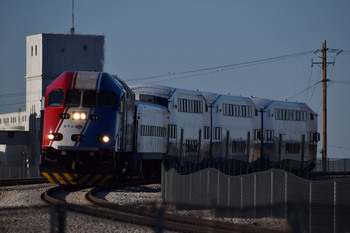 : Ogden, UT. Sep. 10, 2014
: Ogden, UT. Sep. 10, 2014
Commuter trains are easy to capture the whole consist compared with the freight trains. They are relatively short, they appear regularly and they appear on time.
New Mexico Rail Runner Express train tied down at Santa Fe depot has consisted of only three. UTA FrontRunner train caught at Ogden Union Station was consisted of five.
Records of the whole consist of a passenger train often appear in books and magazines by means of words and pictures. But the record of the whole consist of a freight train is few. The only one I remember is the fold-out page appeared in the Nov. 1995 Trains magazine showing the whole side view of a UP manifest by means of series of photos.
Capturing a whole train in a movie became relatively easy today by the development of the smartphone cameras. But doing the same in a photo would still be difficult: train is long and fast, and the right of way is crowded with the obstructions. Here is my quest:
 : Las Cruses, NM. Sep. 10, 2015
: Las Cruses, NM. Sep. 10, 2015 : Marfa, TX. Sep. 11, 2015
: Marfa, TX. Sep. 11, 2015Extras are easy to capture the whole consist compared with the regular trains, as they are relatively short. But the problem is that it’s hard to predict the appearance.
The BNSF extra I happened to meet at Las Cruces, NM has consisted of only four; two locomotives and two MOW cars, BNSF #80 and #81. The UP extra I barely caught over the yucca at Marfa, TX has also consisted of four; two locomotives, a flat car, and a track inspection car #EC-4.
 : Santa Fe, NM. Sep. 13, 2015
: Santa Fe, NM. Sep. 13, 2015 : Ogden, UT. Sep. 10, 2014
: Ogden, UT. Sep. 10, 2014Commuter trains are easy to capture the whole consist compared with the freight trains. They are relatively short, they appear regularly and they appear on time.
New Mexico Rail Runner Express train tied down at Santa Fe depot has consisted of only three. UTA FrontRunner train caught at Ogden Union Station was consisted of five.
2015-12-04 09:00
コメント(0)
Capturing Whole Consist, part 2 – Passengers and Freights [Column_Tracksides]
Capturing a whole train in a movie became relatively easy today by the development of the smartphone cameras. But doing the same in a photo would still be difficult; trains are long and fast, and the right of way is crowded with the obstructions. Here is my quest:
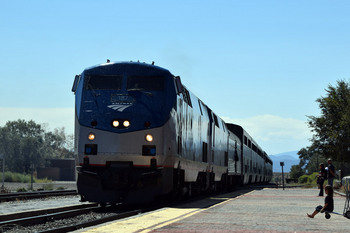 : Lamy, NM. Sep. 13, 2015
: Lamy, NM. Sep. 13, 2015
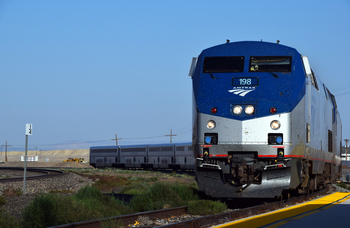 : Green River, UT. Sep. 11, 2014
: Green River, UT. Sep. 11, 2014
Passenger trains today are also easy to capture the whole consist compared with the freight trains. They are relatively short, they appear regularly and they (somewhat) appear on time.
Eastbound Amtrak Southwest Chief arriving at Lamy, NM 40 minutes late has consisted of eleven; two locomotives, a baggage car, three coaches, a lounge car, a dining car, and three sleeping cars. Eastbound Amtrak California Zephyr arriving at Green River, UT 50 minutes late was also consisted of eleven.
The problem is that they look the same: I think Amtrak should put up head and/or tail sign, aka drumhead, to show the particular identity of each train as they used to.
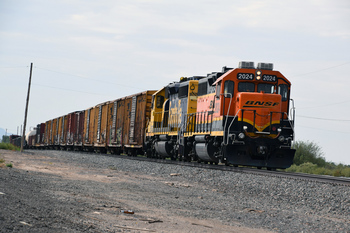 : Vinton, TX. Sep. 10, 2015
: Vinton, TX. Sep. 10, 2015
Freight trains are awkward to capture the whole consists. Today, they are much longer than the train I caught in 1971. Though locals would still be a dominant candidate in capturing the whole consist. The photo above shows the whole consist of BNSF local out of El Paso with a caboose used as a shoving platform. You can barely see the cupola and smokestack of the caboose.
Mainline freight trains are the hard nuts. The photo below shows how I missed to capture it in spite of using the 18mm lens in vast plains. I finally found that the track should rather be twisty than straight. And the viewpoint should be raised from the track level.
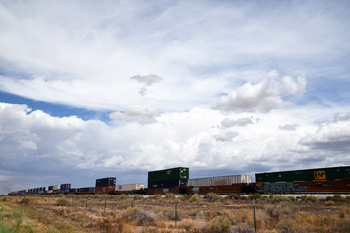 : Three Rivers, NM. Sep. 9, 2015
: Three Rivers, NM. Sep. 9, 2015
The former Rio Grande main in Utah I visited last year was relatively twisty and had several raised viewpoints easy to access, but, unfortunately, the trains were few. So, this time, I took up my position at the highway overpass on the busy BNSF Transcon located at the east of Encino, NM.
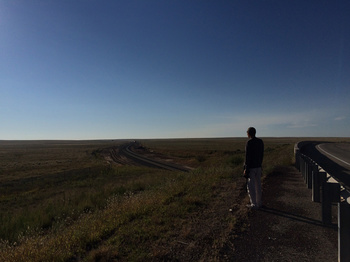
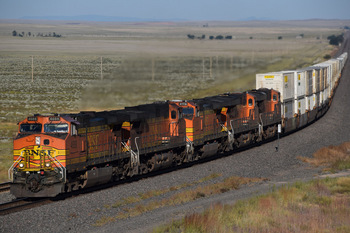 : Encino, NM. Sep. 13, 2015
: Encino, NM. Sep. 13, 2015
Here, I finally captured the whole train; shown above is an eastbound intermodal train. But the rear end is hardly visible since railroads dropped cabooses and stacked containers. Accordingly, I looked opposite direction to find a westbound unit grain train with DPUs coming in exchange.
Hopper cars are low enough not to hide the DPUs, and the DPUs clearly show the rear end of the train. Furthermore, the train has consisted of almost all BNSF equipment. This is it! The photo below is the result of my quest for the year 2015.
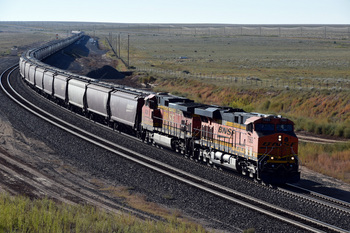 : Encino, NM. Sep. 13, 2015
: Encino, NM. Sep. 13, 2015
 : Lamy, NM. Sep. 13, 2015
: Lamy, NM. Sep. 13, 2015 : Green River, UT. Sep. 11, 2014
: Green River, UT. Sep. 11, 2014Passenger trains today are also easy to capture the whole consist compared with the freight trains. They are relatively short, they appear regularly and they (somewhat) appear on time.
Eastbound Amtrak Southwest Chief arriving at Lamy, NM 40 minutes late has consisted of eleven; two locomotives, a baggage car, three coaches, a lounge car, a dining car, and three sleeping cars. Eastbound Amtrak California Zephyr arriving at Green River, UT 50 minutes late was also consisted of eleven.
The problem is that they look the same: I think Amtrak should put up head and/or tail sign, aka drumhead, to show the particular identity of each train as they used to.
 : Vinton, TX. Sep. 10, 2015
: Vinton, TX. Sep. 10, 2015Freight trains are awkward to capture the whole consists. Today, they are much longer than the train I caught in 1971. Though locals would still be a dominant candidate in capturing the whole consist. The photo above shows the whole consist of BNSF local out of El Paso with a caboose used as a shoving platform. You can barely see the cupola and smokestack of the caboose.
Mainline freight trains are the hard nuts. The photo below shows how I missed to capture it in spite of using the 18mm lens in vast plains. I finally found that the track should rather be twisty than straight. And the viewpoint should be raised from the track level.
 : Three Rivers, NM. Sep. 9, 2015
: Three Rivers, NM. Sep. 9, 2015The former Rio Grande main in Utah I visited last year was relatively twisty and had several raised viewpoints easy to access, but, unfortunately, the trains were few. So, this time, I took up my position at the highway overpass on the busy BNSF Transcon located at the east of Encino, NM.

 : Encino, NM. Sep. 13, 2015
: Encino, NM. Sep. 13, 2015Here, I finally captured the whole train; shown above is an eastbound intermodal train. But the rear end is hardly visible since railroads dropped cabooses and stacked containers. Accordingly, I looked opposite direction to find a westbound unit grain train with DPUs coming in exchange.
Hopper cars are low enough not to hide the DPUs, and the DPUs clearly show the rear end of the train. Furthermore, the train has consisted of almost all BNSF equipment. This is it! The photo below is the result of my quest for the year 2015.
 : Encino, NM. Sep. 13, 2015
: Encino, NM. Sep. 13, 20152015-12-11 09:00
コメント(0)
Unknown Sierra Blanca, part 1 [Column_Tracksides]
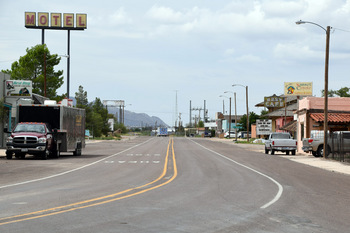 : Sierra Blanca, TX. Sep. 10, 2015
: Sierra Blanca, TX. Sep. 10, 2015The first transcontinental railroad was, as you know, completed on May 10, 1869, at Promontory, UT. Then, how many of you know the second? I didn’t know.
The second transcontinental railroad seems rather complicated.
A history says the second transcontinental railroad was completed by Southern Pacific and Texas & Pacific on Dec. 15, 1881 at Sierra Blanca, TX[1]. Another history says Atchison, Topeka & Santa Fe and Southern Pacific met on Mar. 8, the same year at Deming, NM: nine months earlier than Sierra Blanca[2]. It is said that officials from companies even drove a silver spike at both Sierra Blanca and Deming.
Richard Boehle points out that the Deming connection’s little traffic is the cause for the existence of two histories[3]. Fred Frailey tells the ATSF’s completion of own route to the Pacific soon after the completion of Deming connection is the cause of the confusion[4]. Another view of the cause is that SP–T&P connection was the chartered and the SP–ATSF connection was the coincidence. Anyway, Sierra Blanca seems to won the honor of the silver spiked place.
Deming and Sierra Blanca chose a different path after their silver spikes: as of 2010 Census, the population of Deming is 14885, while it of Sierra Blanca is 553. Amtrak Sunset Limited makes a stop at Deming but passes Sierra Blanca.
Rooting for the underdog, I visited Sierra Blanca.
[1] Texas Historical Commission web page;
[2] The Great American Stations web page;
[3] Rails West web page;
[4] Trains magazine web page;
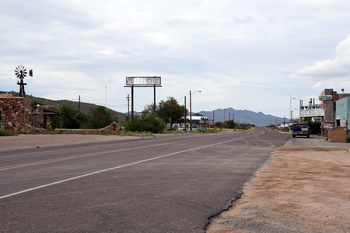 : Sierra Blanca, TX. Sep. 10, 2015
: Sierra Blanca, TX. Sep. 10, 20152016-05-06 09:00
コメント(0)
Unknown Sierra Blanca, part 2 [Column_Tracksides]
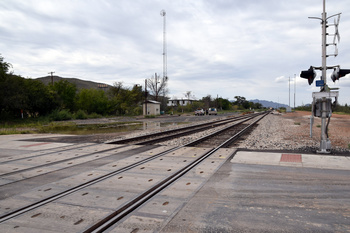 : Sierra Blanca, TX. Sep. 10, 2015
: Sierra Blanca, TX. Sep. 10, 2015Sierra Blanca founded in 1881 is the county seat of Hudspeth County, Texas. It is named after the Sierra Blanca Mountains located northwest of the town.
It seemed rather obsolete when we visited the town last year.
At the corner of El Paso St. and Archie Ave, which is said to be the only paved roads in town, stand two historical markers erected by the state of Texas. One is of Killing of General J. J. Byrne. Another with a wheel is of America’s Second Transcontinental Railroad[1].
The railroad itself seemed busy at Sierra Blanca. Here, the original former SP–T&P route and the former SP sunset route diverge. When we visited the former depot site at the diverging point, an eastbound was in the hole may be waiting for the oncoming train on the former T&P route: line diverging to the left in the photo above is the Sunset Route completed in 1883.
Depot structure is preserved: it is moved from the original site to the center of town next to the post office on El Paso St, housing a museum[2]. May 1984 Trains magazine shows the photo of the depot standing at the original site. The museum is open only on Wednesday afternoon. SP caboose and a searchlight style signal are also preserved next to the depot. Former Sierra Hotel structure behind the caboose would also be worth a look.
Another railroad related story found at Sierra Blanca is a damn business. According to several web sites, Sierra Blanca was once the nation’s largest dump of sewage sludge generated at New York City[3]. Since 1992, New York City sent 250 tons a day of sludge by COFC flat cars to the spur at the waste site called Mile High Ranch located just west of town. They just sprayed the sludge to the vast land, which caused local health concerns. The dumping lasted until 2001. The spur itself seems still existed according to Google maps.
Accordingly, there is no frill commemorating the second transcontinental railroad completed here: compared with the golden spike site, the silver spike site is somewhat forgotten and desolated. But, for me, nothing is better than not the setup but the genuine railroad.
[1] Texas Historical Commission web page;
[2] Texas Mountain Trail Region web page;
[3] The Center for Land Use Interpretation web page
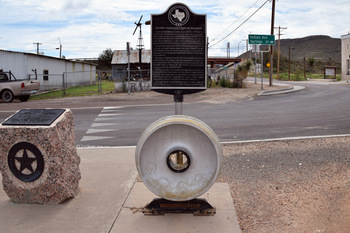
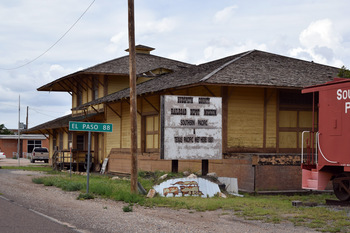 : Sierra Blanca, TX. Sep. 10, 2015
: Sierra Blanca, TX. Sep. 10, 20152016-05-13 09:00
コメント(0)
Unique Loads – 01 : Wind Mill Blades [Column_Tracksides]
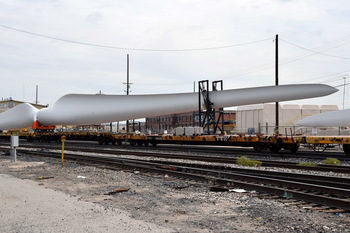 : El Paso, TX. Sep. 10, 2015
: El Paso, TX. Sep. 10, 2015On a bit cloudy noon at El Paso, Texas, we happened to see these extra long loads slowly meandering through the city; I’ve never seen this kind of load except in models.
The blade shown above seems a little longer than two TTX 89' flat cars. According to the UP website, they seem typical 177-foot-long blades. Surprisingly, UP accepts 264-foot-long ones[1]. It was a kind of miracle for me they negotiated the tight S curves located in the UP yard; I should have recorded it in a movie.
[1] "Union Pacific Ships Longest Wind Turbine Blades in Company History", Innovation, Apr. 23, 2024, InsideTrack;
revised, Apr. 24, 2024
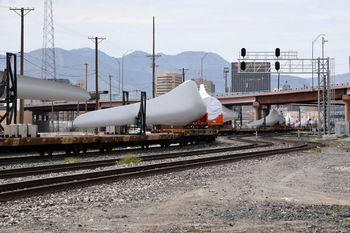 : El Paso, TX. Sep. 10, 2015
: El Paso, TX. Sep. 10, 20152016-07-01 09:00
コメント(0)
Unique Loads – 02 : Red Hot Chile Peppers [Column_Tracksides]
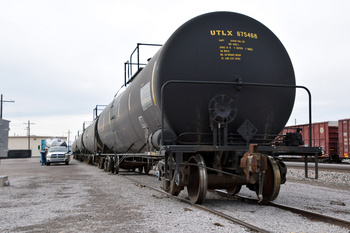
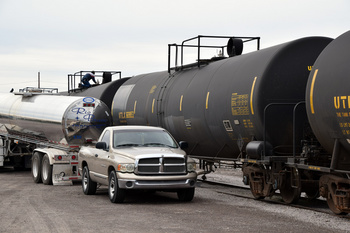
 : Las Cruces, NM. Sep. 10, 2015
: Las Cruces, NM. Sep. 10, 2015On a cloudy Thursday morning at Las Cruces depot in New Mexico, we found a string of UTLX 23,000-gallon Funnel Flow tank cars without US DOT HazMat Placards and guys working on it. The commodity they are loading, originally told us as “Top Secret!”, turned out to be the mashed and salted red hot chile peppers (New Mexicans seem to prefer chile than chili).
Green and red chile peppers are the specialties of the region. As they told us, chile peppers can be harvested year-round in this region, which gains an advantage over other chile-producing districts in the world. Accordingly, they ship 37 cars a month of salted red chile juice to St Louis, Missouri. There, spices and additives are added to produce salsa sauce.
Of course, chile is not explosive, nor flammable, nor poison nor radioactive. But the juice might be hazardous if you pour it on yourself: "You need HazMat Placards!" was my joke in return.
 : fresh green chili, and
: fresh green chili, and : bottled salsa sauce at Silva's in El Paso
: bottled salsa sauce at Silva's in El PasoThree days later, we saw similar tank cars with, this time, HazMat Placards. MWTX #112657 shows class 3 #1987 HazMat Placards match with the lessee name Midwest Ethanol Transport LLC attached on the trunk.
revised, Dec. 26, 2016
* information on US DOT HazMat Placards;
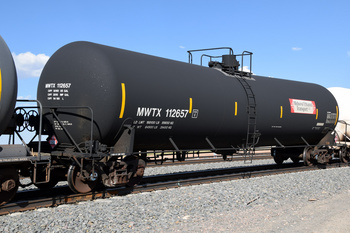 : Vaughn, NM. Sep. 12, 2015
: Vaughn, NM. Sep. 12, 20152016-07-08 09:00
コメント(0)
Oak Tree Inn [Column_Tracksides]
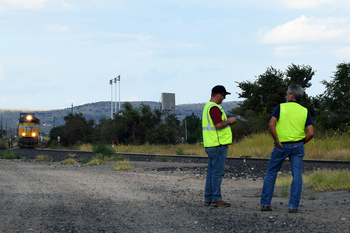
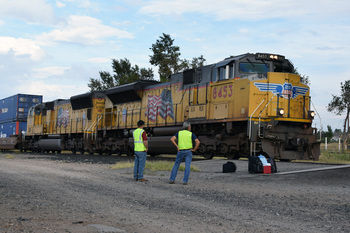 : Alpine, TX. Sep. 10, 2015
: Alpine, TX. Sep. 10, 2015It’s five-thirty in the evening here in Alpine, TX. The westbound train gradually drops speed toward the 5th street crossing. Here, two guys with luggage, icebox and a plastic bag full of ice waiting for the train to stop. It’s the crew change.
Once, expired crews dropped in at the Railroad YMCA or the hotel opposite the track, like La Salle Hotel at Helper, UT. Today, discharged UP crews here at Alpine get into a white van: they will be guests at accommodations called Oak Tree Inn located at the east end of town. The Inn is not managed but provided by the railroad.
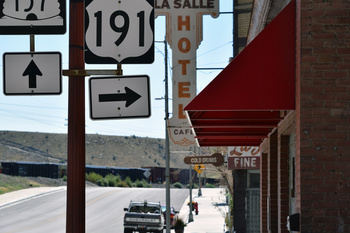 : Helper, UT. Sep. 10, 2014
: Helper, UT. Sep. 10, 2014Oak Tree Inn is the railroad crew priority accommodations declaring “Dark and Quiet”[1]. They are owned by AHIP(American Hotel Income Properties) REIT LP headquartered in Vancouver, BC, Canada[2]. At the point of writing, AHIP owns 45 railroad oriented accommodations in the united States according to their web page.
Noteworthy is that we can also stay at Oak Tree Inn if they have room. The rooms were moderate but modern and clean, if anything, a little pricy for us the outsiders. Guests check-in and out 24 hours due to its prior purpose. But It’s the only accommodations in remote places like Vaughn, NM which we can make a reservation on the web.
However, unfortunately, Oak Tree Inn became Travelodge by Wyndham in 2017; can't tell which is the railroad hotel by its name any more[3].
revised, Dec. 29, 2019
[1] Oak Tree Inn web site;[2] AHIP web site;
[3] "Oak Tree Inn Converts 44 Hotels to Wyndham Blands", Dec. 21, 2017, Lodging;
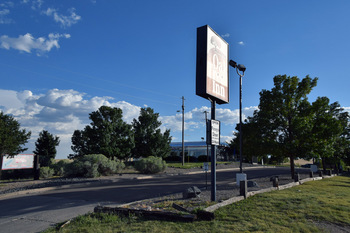
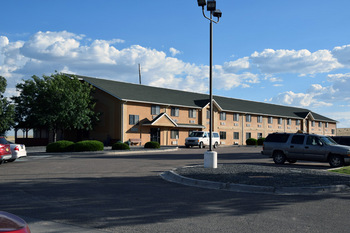 : Vaughn, NM. Sep. 12, 2015
: Vaughn, NM. Sep. 12, 20152016-08-05 09:00
コメント(0)
Penny’s Diner [Column_Tracksides]
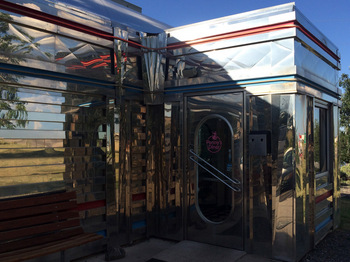 : Vaughn, NM. Sep. 12, 2015
: Vaughn, NM. Sep. 12, 2015The Oak Tree Inn also operates 24 hour eating place named Penny’s Diner next to it. It seemed the only eating place operating at eight in the evening in Vaughn. We enjoyed “Cherry Soda”, “Breakfast Steak” and “Chef Salad” for the dinner. If you reserved an Oak Tree Inn room at Vaughn, visit Penny’s Diner first. Your check in is handled at the Diner.
BNSF also offers similar facilities. The 24 hour eating place named Rio Grande Diner welcomes us at Belen, NM. The facilities are also owned by AHIP, but the accommodations seemed only accepting BNSF crews.
Besides staying at the railroad hotel, we the rail fans can gain some more from the inns. According to the list on web, we can know the place where crew changes, and how busy the railroad is from the number of rooms. For example, Green River, WY on UP Overland route has 191 rooms and Belen, NM on BNSF Transcon route has 160. Vice versa, Yampa, CO on former D&RGW Craig Branch has modest 37 rooms and Dunsmuir, CA on former SP Shasta route has only 21. Alpine, TX has also modest 40 rooms.
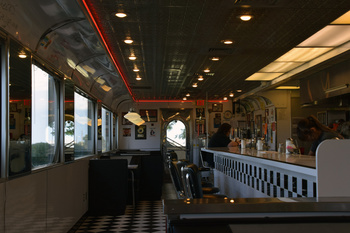
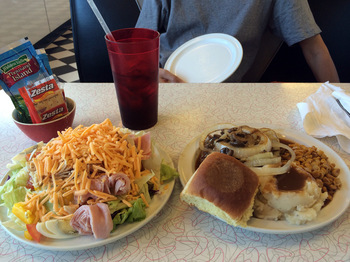 : Vaughn, NM. Sep. 12, 2015
: Vaughn, NM. Sep. 12, 20152016-08-06 09:00
コメント(0)
Hemingray Insulators [Column_Tracksides]
 : Hemingray No. 42 Double Petticoat, 24 Oz Insulator produced in 1943
: Hemingray No. 42 Double Petticoat, 24 Oz Insulator produced in 1943Line poles along the track were at times the intimates and at times the obstacles. When I was a boy, I believed that the number of insulators on line poles suggests the frequency of trains. So, I was delighted to see line poles with many insulators.
The most impressive feature of line poles with insulators in North America was that most of the insulators were made of glass. The iridescent sparkles of insulators in backlight were the miracle for the boy who didn’t know they were made of glass[1]. Accordingly, the insulator was one of the subjects of my fetishism.
The insulator shown above is the one I happened to find during our trip to New Mexico at the Casa Grande Trading Post in Los Cerrillos along former ATSF Raton Pass route. Honestly speaking, I bothered to visit the shop as I found at Google Street View that they had countless insulators on their storefront.
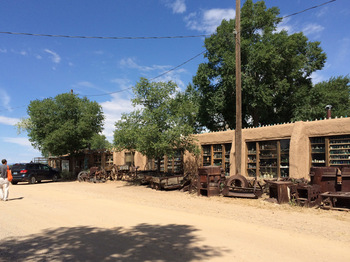 : Los Cerrrillos, NM. Sep. 14, 2015
: Los Cerrrillos, NM. Sep. 14, 2015According to Christian Willis of Hemingray.info site, my insulator is the most popular and prolific product manufactured by Hemingray Glass Company[2].
Hemingray Glass Company was founded in 1848 at Cincinnati, Ohio by Robert Hemingray and Ralph Glay. The company became the most prolific glass insulator manufacturer in the world. Its main factory was located at Muncie, Indiana. The company was purchased by Owens-Illinois Glass Company in 1933. Unfortunately, however, the glass insulator production at Muncie was ended in 1967[3].
My surprise is not that my insulator is worth only a dollar or less, but that there exist quite a number of insulator collectors and the market.
[1] Insulator Colors by John & Carol McDougald;
[2] Hemingray.info site;
[3] brief company story by Bob Stahr;
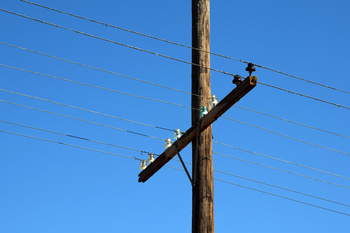 : Ribera, NM. Sep. 13, 2015
: Ribera, NM. Sep. 13, 2015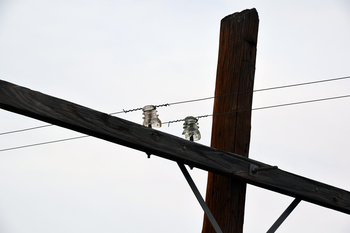 : : Las Cruses, NM. Sep. 10, 2015
: : Las Cruses, NM. Sep. 10, 20152017-01-13 09:00
コメント(0)



